Case Study: Kellogg's - Workplace Culture, Motivation, and Performance
VerifiedAdded on 2020/11/12
|9
|2519
|207
Case Study
AI Summary
This case study examines Kellogg's workplace environment, focusing on its organizational structure, culture, and employee motivation strategies. It explores how Kellogg's fosters a positive and flexible work environment, emphasizing the importance of shared beliefs and common goals. The analysis delves into the company's use of behavioral management theory, considering individual and group dynamics, informal leadership, and employee participation. It also investigates Kellogg's approach to motivation, including the application of scientific management principles (rewards and benefits) and Maslow's hierarchy of needs. The study highlights how Kellogg's provides competitive salaries, flexible benefits, and opportunities for self-actualization to enhance employee performance and satisfaction. The case study provides a detailed overview of Kellogg's practices, demonstrating how they contribute to the company's success and its ranking as a top employer.
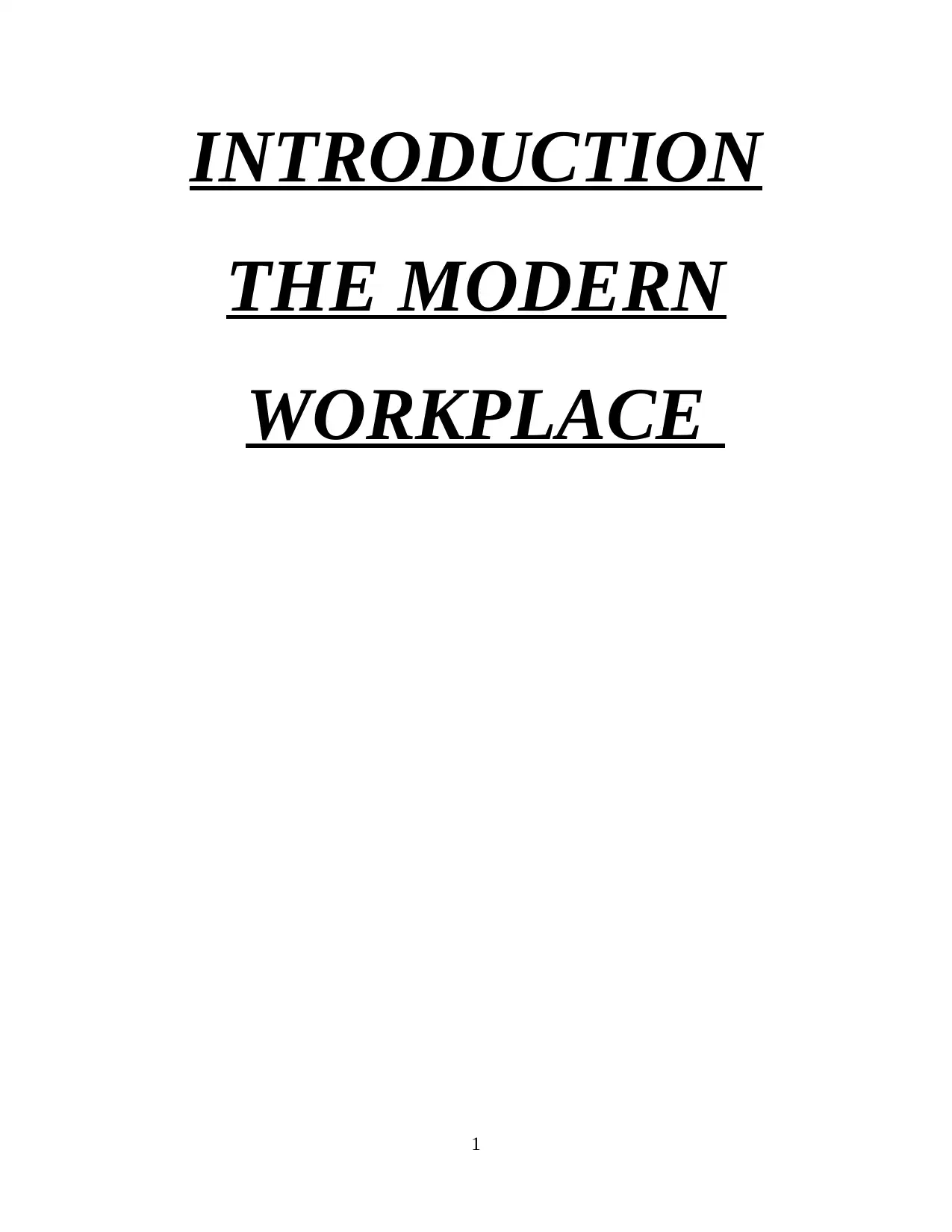
INTRODUCTION
THE MODERN
WORKPLACE
1
THE MODERN
WORKPLACE
1
Paraphrase This Document
Need a fresh take? Get an instant paraphrase of this document with our AI Paraphraser
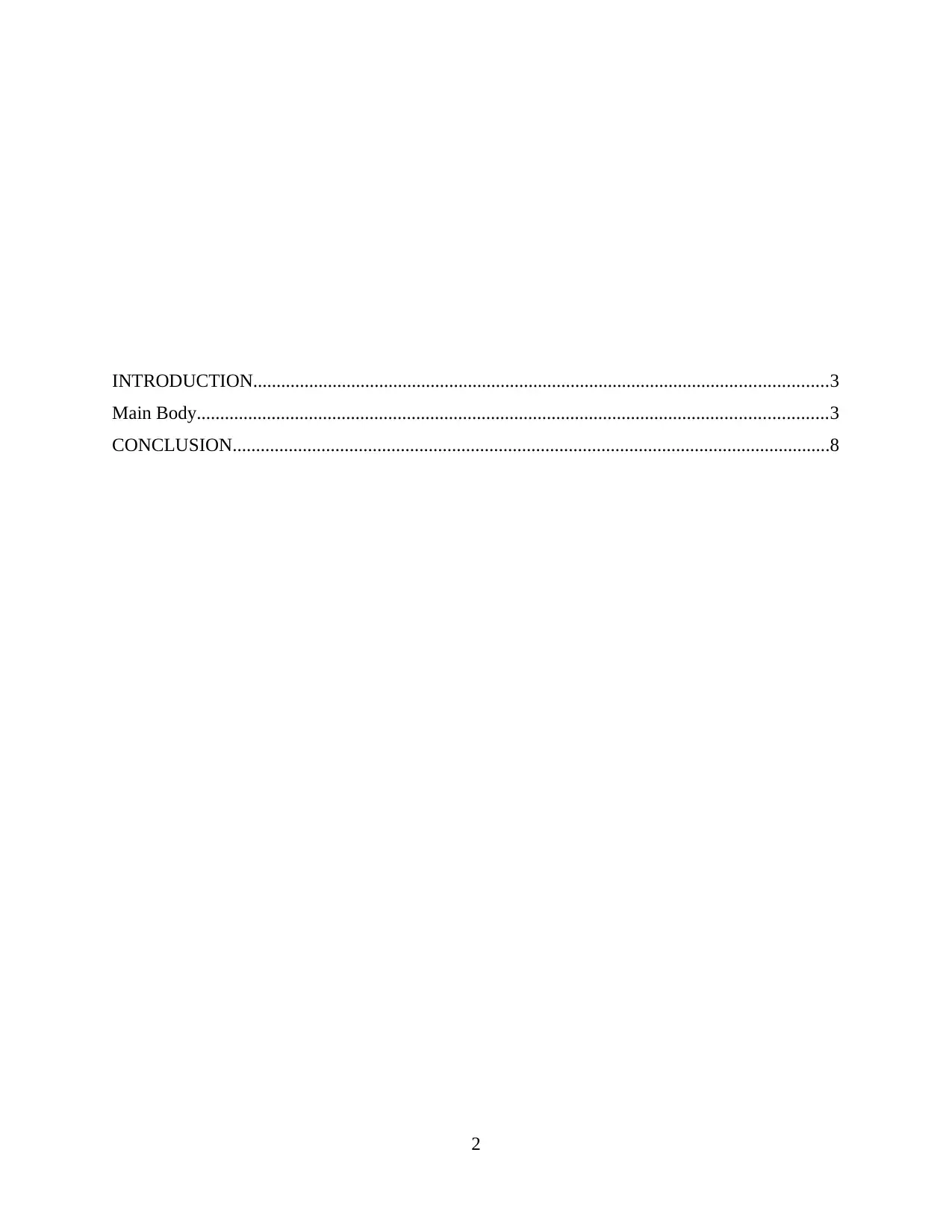
INTRODUCTION...........................................................................................................................3
Main Body.......................................................................................................................................3
CONCLUSION................................................................................................................................8
2
Main Body.......................................................................................................................................3
CONCLUSION................................................................................................................................8
2
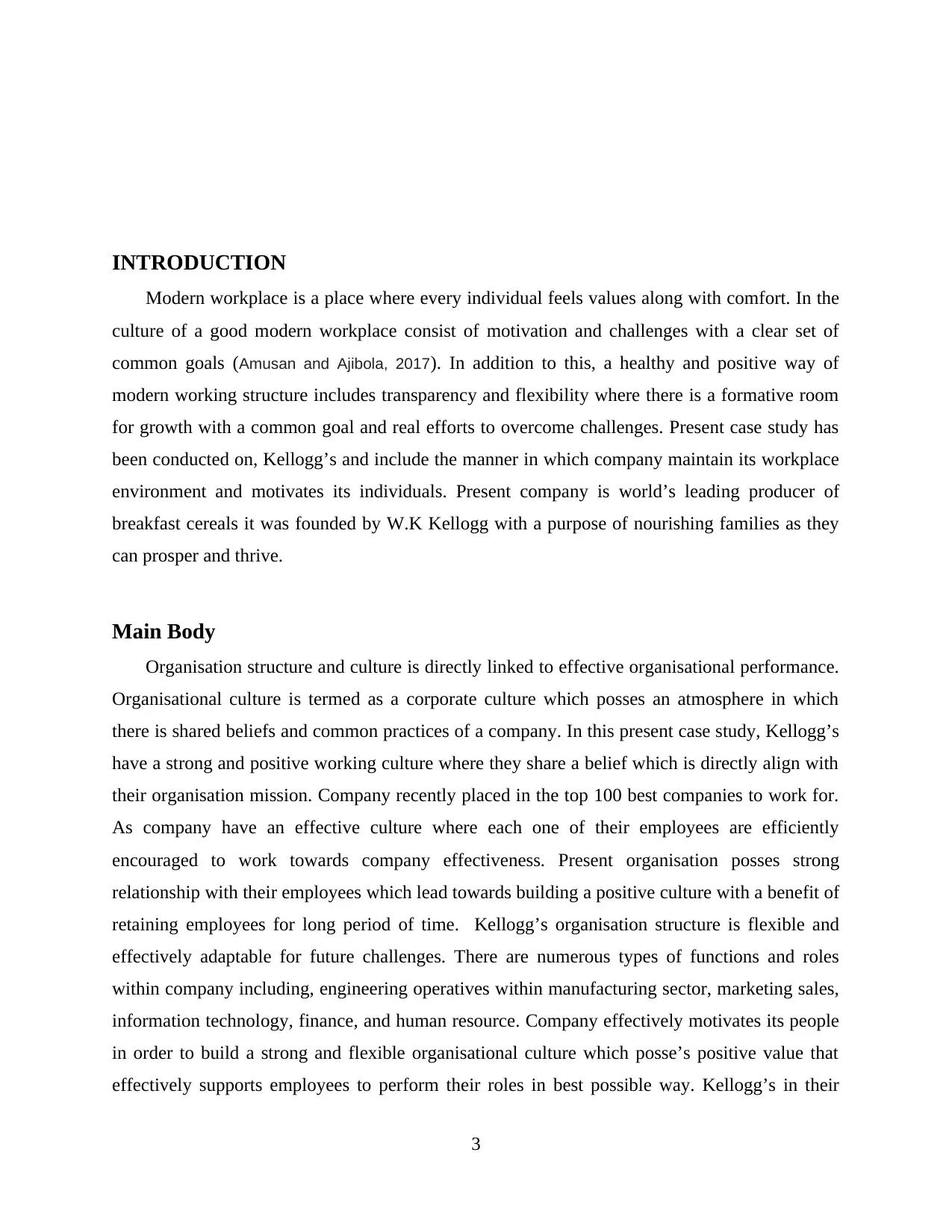
INTRODUCTION
Modern workplace is a place where every individual feels values along with comfort. In the
culture of a good modern workplace consist of motivation and challenges with a clear set of
common goals (Amusan and Ajibola, 2017). In addition to this, a healthy and positive way of
modern working structure includes transparency and flexibility where there is a formative room
for growth with a common goal and real efforts to overcome challenges. Present case study has
been conducted on, Kellogg’s and include the manner in which company maintain its workplace
environment and motivates its individuals. Present company is world’s leading producer of
breakfast cereals it was founded by W.K Kellogg with a purpose of nourishing families as they
can prosper and thrive.
Main Body
Organisation structure and culture is directly linked to effective organisational performance.
Organisational culture is termed as a corporate culture which posses an atmosphere in which
there is shared beliefs and common practices of a company. In this present case study, Kellogg’s
have a strong and positive working culture where they share a belief which is directly align with
their organisation mission. Company recently placed in the top 100 best companies to work for.
As company have an effective culture where each one of their employees are efficiently
encouraged to work towards company effectiveness. Present organisation posses strong
relationship with their employees which lead towards building a positive culture with a benefit of
retaining employees for long period of time. Kellogg’s organisation structure is flexible and
effectively adaptable for future challenges. There are numerous types of functions and roles
within company including, engineering operatives within manufacturing sector, marketing sales,
information technology, finance, and human resource. Company effectively motivates its people
in order to build a strong and flexible organisational culture which posse’s positive value that
effectively supports employees to perform their roles in best possible way. Kellogg’s in their
3
Modern workplace is a place where every individual feels values along with comfort. In the
culture of a good modern workplace consist of motivation and challenges with a clear set of
common goals (Amusan and Ajibola, 2017). In addition to this, a healthy and positive way of
modern working structure includes transparency and flexibility where there is a formative room
for growth with a common goal and real efforts to overcome challenges. Present case study has
been conducted on, Kellogg’s and include the manner in which company maintain its workplace
environment and motivates its individuals. Present company is world’s leading producer of
breakfast cereals it was founded by W.K Kellogg with a purpose of nourishing families as they
can prosper and thrive.
Main Body
Organisation structure and culture is directly linked to effective organisational performance.
Organisational culture is termed as a corporate culture which posses an atmosphere in which
there is shared beliefs and common practices of a company. In this present case study, Kellogg’s
have a strong and positive working culture where they share a belief which is directly align with
their organisation mission. Company recently placed in the top 100 best companies to work for.
As company have an effective culture where each one of their employees are efficiently
encouraged to work towards company effectiveness. Present organisation posses strong
relationship with their employees which lead towards building a positive culture with a benefit of
retaining employees for long period of time. Kellogg’s organisation structure is flexible and
effectively adaptable for future challenges. There are numerous types of functions and roles
within company including, engineering operatives within manufacturing sector, marketing sales,
information technology, finance, and human resource. Company effectively motivates its people
in order to build a strong and flexible organisational culture which posse’s positive value that
effectively supports employees to perform their roles in best possible way. Kellogg’s in their
3
⊘ This is a preview!⊘
Do you want full access?
Subscribe today to unlock all pages.

Trusted by 1+ million students worldwide
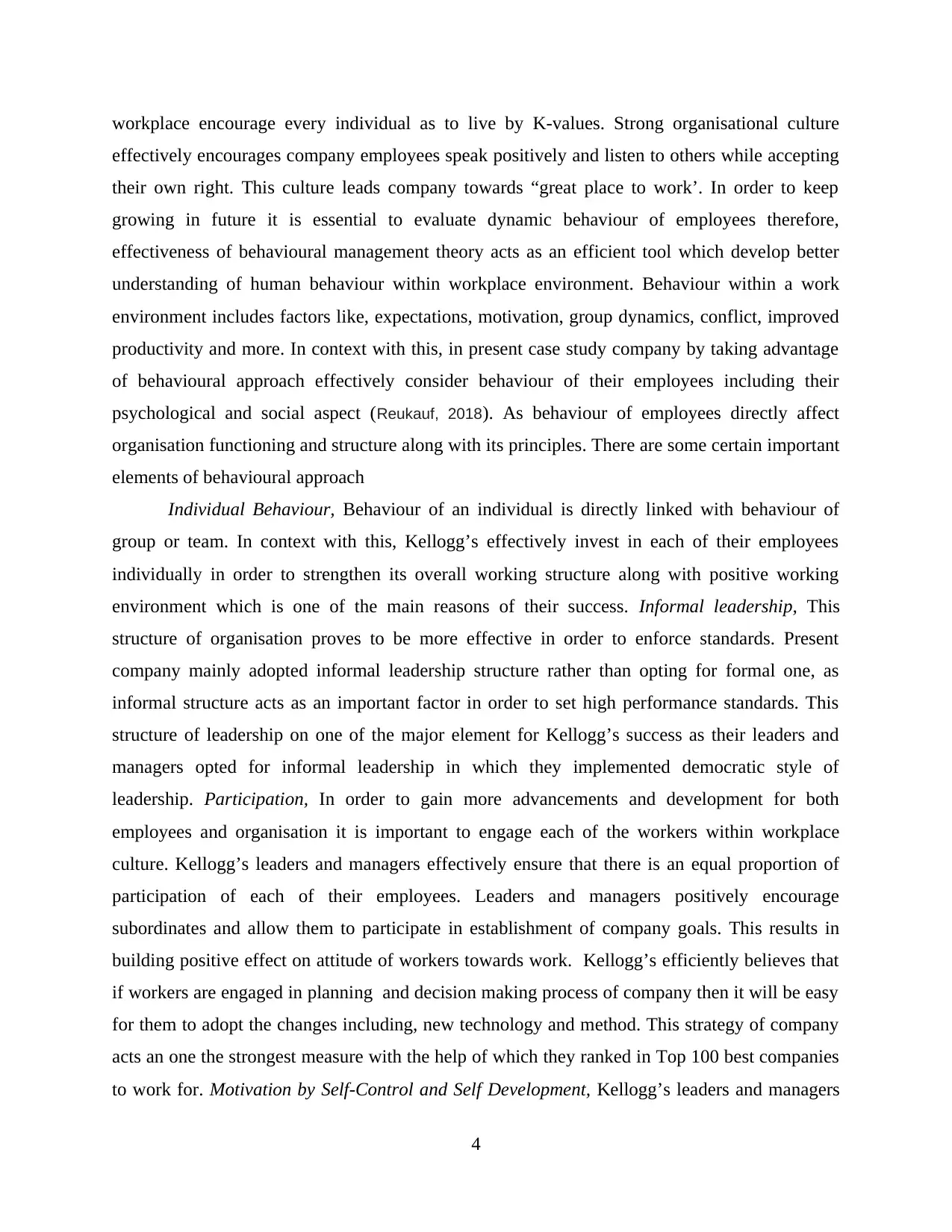
workplace encourage every individual as to live by K-values. Strong organisational culture
effectively encourages company employees speak positively and listen to others while accepting
their own right. This culture leads company towards “great place to work’. In order to keep
growing in future it is essential to evaluate dynamic behaviour of employees therefore,
effectiveness of behavioural management theory acts as an efficient tool which develop better
understanding of human behaviour within workplace environment. Behaviour within a work
environment includes factors like, expectations, motivation, group dynamics, conflict, improved
productivity and more. In context with this, in present case study company by taking advantage
of behavioural approach effectively consider behaviour of their employees including their
psychological and social aspect (Reukauf, 2018). As behaviour of employees directly affect
organisation functioning and structure along with its principles. There are some certain important
elements of behavioural approach
Individual Behaviour, Behaviour of an individual is directly linked with behaviour of
group or team. In context with this, Kellogg’s effectively invest in each of their employees
individually in order to strengthen its overall working structure along with positive working
environment which is one of the main reasons of their success. Informal leadership, This
structure of organisation proves to be more effective in order to enforce standards. Present
company mainly adopted informal leadership structure rather than opting for formal one, as
informal structure acts as an important factor in order to set high performance standards. This
structure of leadership on one of the major element for Kellogg’s success as their leaders and
managers opted for informal leadership in which they implemented democratic style of
leadership. Participation, In order to gain more advancements and development for both
employees and organisation it is important to engage each of the workers within workplace
culture. Kellogg’s leaders and managers effectively ensure that there is an equal proportion of
participation of each of their employees. Leaders and managers positively encourage
subordinates and allow them to participate in establishment of company goals. This results in
building positive effect on attitude of workers towards work. Kellogg’s efficiently believes that
if workers are engaged in planning and decision making process of company then it will be easy
for them to adopt the changes including, new technology and method. This strategy of company
acts an one the strongest measure with the help of which they ranked in Top 100 best companies
to work for. Motivation by Self-Control and Self Development, Kellogg’s leaders and managers
4
effectively encourages company employees speak positively and listen to others while accepting
their own right. This culture leads company towards “great place to work’. In order to keep
growing in future it is essential to evaluate dynamic behaviour of employees therefore,
effectiveness of behavioural management theory acts as an efficient tool which develop better
understanding of human behaviour within workplace environment. Behaviour within a work
environment includes factors like, expectations, motivation, group dynamics, conflict, improved
productivity and more. In context with this, in present case study company by taking advantage
of behavioural approach effectively consider behaviour of their employees including their
psychological and social aspect (Reukauf, 2018). As behaviour of employees directly affect
organisation functioning and structure along with its principles. There are some certain important
elements of behavioural approach
Individual Behaviour, Behaviour of an individual is directly linked with behaviour of
group or team. In context with this, Kellogg’s effectively invest in each of their employees
individually in order to strengthen its overall working structure along with positive working
environment which is one of the main reasons of their success. Informal leadership, This
structure of organisation proves to be more effective in order to enforce standards. Present
company mainly adopted informal leadership structure rather than opting for formal one, as
informal structure acts as an important factor in order to set high performance standards. This
structure of leadership on one of the major element for Kellogg’s success as their leaders and
managers opted for informal leadership in which they implemented democratic style of
leadership. Participation, In order to gain more advancements and development for both
employees and organisation it is important to engage each of the workers within workplace
culture. Kellogg’s leaders and managers effectively ensure that there is an equal proportion of
participation of each of their employees. Leaders and managers positively encourage
subordinates and allow them to participate in establishment of company goals. This results in
building positive effect on attitude of workers towards work. Kellogg’s efficiently believes that
if workers are engaged in planning and decision making process of company then it will be easy
for them to adopt the changes including, new technology and method. This strategy of company
acts an one the strongest measure with the help of which they ranked in Top 100 best companies
to work for. Motivation by Self-Control and Self Development, Kellogg’s leaders and managers
4
Paraphrase This Document
Need a fresh take? Get an instant paraphrase of this document with our AI Paraphraser
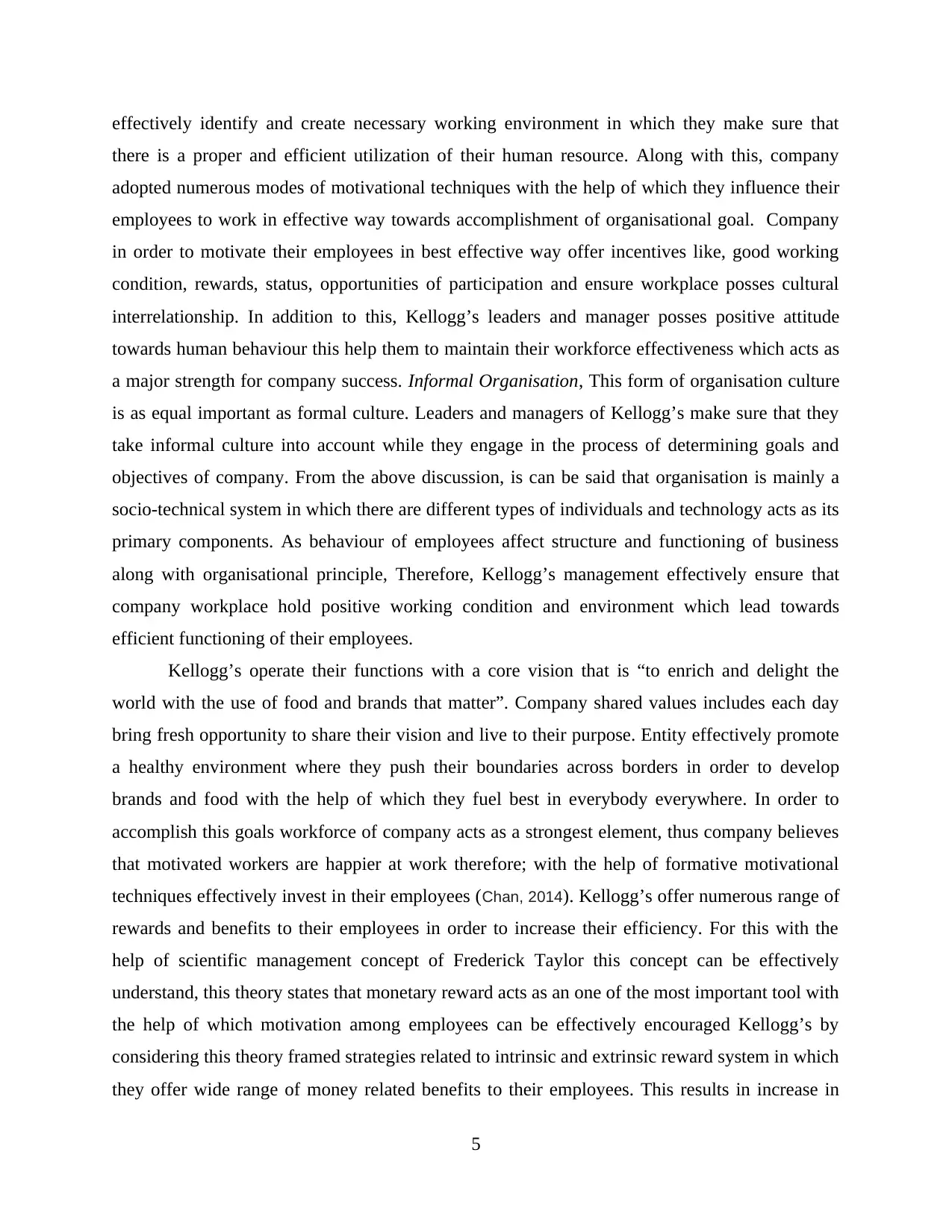
effectively identify and create necessary working environment in which they make sure that
there is a proper and efficient utilization of their human resource. Along with this, company
adopted numerous modes of motivational techniques with the help of which they influence their
employees to work in effective way towards accomplishment of organisational goal. Company
in order to motivate their employees in best effective way offer incentives like, good working
condition, rewards, status, opportunities of participation and ensure workplace posses cultural
interrelationship. In addition to this, Kellogg’s leaders and manager posses positive attitude
towards human behaviour this help them to maintain their workforce effectiveness which acts as
a major strength for company success. Informal Organisation, This form of organisation culture
is as equal important as formal culture. Leaders and managers of Kellogg’s make sure that they
take informal culture into account while they engage in the process of determining goals and
objectives of company. From the above discussion, is can be said that organisation is mainly a
socio-technical system in which there are different types of individuals and technology acts as its
primary components. As behaviour of employees affect structure and functioning of business
along with organisational principle, Therefore, Kellogg’s management effectively ensure that
company workplace hold positive working condition and environment which lead towards
efficient functioning of their employees.
Kellogg’s operate their functions with a core vision that is “to enrich and delight the
world with the use of food and brands that matter”. Company shared values includes each day
bring fresh opportunity to share their vision and live to their purpose. Entity effectively promote
a healthy environment where they push their boundaries across borders in order to develop
brands and food with the help of which they fuel best in everybody everywhere. In order to
accomplish this goals workforce of company acts as a strongest element, thus company believes
that motivated workers are happier at work therefore; with the help of formative motivational
techniques effectively invest in their employees (Chan, 2014). Kellogg’s offer numerous range of
rewards and benefits to their employees in order to increase their efficiency. For this with the
help of scientific management concept of Frederick Taylor this concept can be effectively
understand, this theory states that monetary reward acts as an one of the most important tool with
the help of which motivation among employees can be effectively encouraged Kellogg’s by
considering this theory framed strategies related to intrinsic and extrinsic reward system in which
they offer wide range of money related benefits to their employees. This results in increase in
5
there is a proper and efficient utilization of their human resource. Along with this, company
adopted numerous modes of motivational techniques with the help of which they influence their
employees to work in effective way towards accomplishment of organisational goal. Company
in order to motivate their employees in best effective way offer incentives like, good working
condition, rewards, status, opportunities of participation and ensure workplace posses cultural
interrelationship. In addition to this, Kellogg’s leaders and manager posses positive attitude
towards human behaviour this help them to maintain their workforce effectiveness which acts as
a major strength for company success. Informal Organisation, This form of organisation culture
is as equal important as formal culture. Leaders and managers of Kellogg’s make sure that they
take informal culture into account while they engage in the process of determining goals and
objectives of company. From the above discussion, is can be said that organisation is mainly a
socio-technical system in which there are different types of individuals and technology acts as its
primary components. As behaviour of employees affect structure and functioning of business
along with organisational principle, Therefore, Kellogg’s management effectively ensure that
company workplace hold positive working condition and environment which lead towards
efficient functioning of their employees.
Kellogg’s operate their functions with a core vision that is “to enrich and delight the
world with the use of food and brands that matter”. Company shared values includes each day
bring fresh opportunity to share their vision and live to their purpose. Entity effectively promote
a healthy environment where they push their boundaries across borders in order to develop
brands and food with the help of which they fuel best in everybody everywhere. In order to
accomplish this goals workforce of company acts as a strongest element, thus company believes
that motivated workers are happier at work therefore; with the help of formative motivational
techniques effectively invest in their employees (Chan, 2014). Kellogg’s offer numerous range of
rewards and benefits to their employees in order to increase their efficiency. For this with the
help of scientific management concept of Frederick Taylor this concept can be effectively
understand, this theory states that monetary reward acts as an one of the most important tool with
the help of which motivation among employees can be effectively encouraged Kellogg’s by
considering this theory framed strategies related to intrinsic and extrinsic reward system in which
they offer wide range of money related benefits to their employees. This results in increase in
5
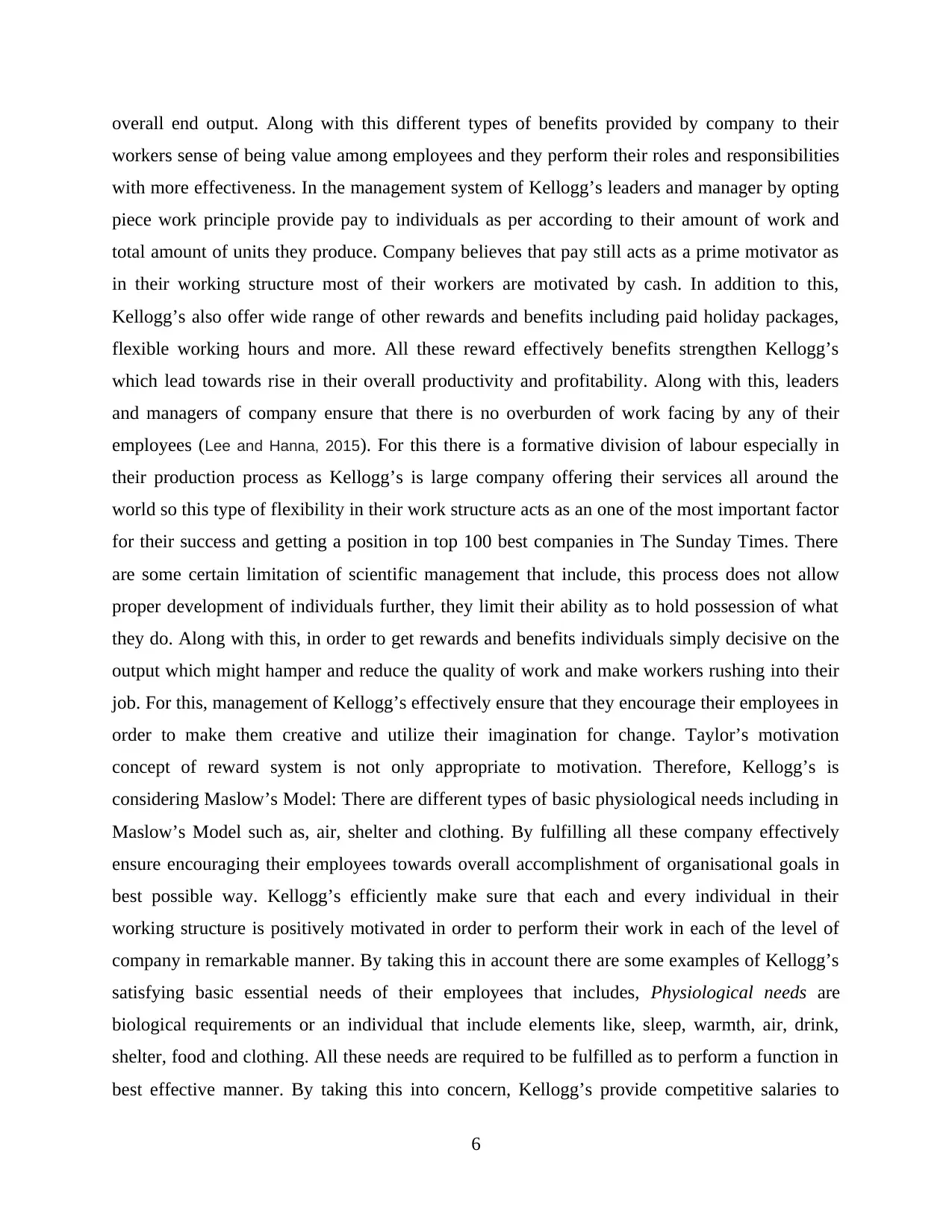
overall end output. Along with this different types of benefits provided by company to their
workers sense of being value among employees and they perform their roles and responsibilities
with more effectiveness. In the management system of Kellogg’s leaders and manager by opting
piece work principle provide pay to individuals as per according to their amount of work and
total amount of units they produce. Company believes that pay still acts as a prime motivator as
in their working structure most of their workers are motivated by cash. In addition to this,
Kellogg’s also offer wide range of other rewards and benefits including paid holiday packages,
flexible working hours and more. All these reward effectively benefits strengthen Kellogg’s
which lead towards rise in their overall productivity and profitability. Along with this, leaders
and managers of company ensure that there is no overburden of work facing by any of their
employees (Lee and Hanna, 2015). For this there is a formative division of labour especially in
their production process as Kellogg’s is large company offering their services all around the
world so this type of flexibility in their work structure acts as an one of the most important factor
for their success and getting a position in top 100 best companies in The Sunday Times. There
are some certain limitation of scientific management that include, this process does not allow
proper development of individuals further, they limit their ability as to hold possession of what
they do. Along with this, in order to get rewards and benefits individuals simply decisive on the
output which might hamper and reduce the quality of work and make workers rushing into their
job. For this, management of Kellogg’s effectively ensure that they encourage their employees in
order to make them creative and utilize their imagination for change. Taylor’s motivation
concept of reward system is not only appropriate to motivation. Therefore, Kellogg’s is
considering Maslow’s Model: There are different types of basic physiological needs including in
Maslow’s Model such as, air, shelter and clothing. By fulfilling all these company effectively
ensure encouraging their employees towards overall accomplishment of organisational goals in
best possible way. Kellogg’s efficiently make sure that each and every individual in their
working structure is positively motivated in order to perform their work in each of the level of
company in remarkable manner. By taking this in account there are some examples of Kellogg’s
satisfying basic essential needs of their employees that includes, Physiological needs are
biological requirements or an individual that include elements like, sleep, warmth, air, drink,
shelter, food and clothing. All these needs are required to be fulfilled as to perform a function in
best effective manner. By taking this into concern, Kellogg’s provide competitive salaries to
6
workers sense of being value among employees and they perform their roles and responsibilities
with more effectiveness. In the management system of Kellogg’s leaders and manager by opting
piece work principle provide pay to individuals as per according to their amount of work and
total amount of units they produce. Company believes that pay still acts as a prime motivator as
in their working structure most of their workers are motivated by cash. In addition to this,
Kellogg’s also offer wide range of other rewards and benefits including paid holiday packages,
flexible working hours and more. All these reward effectively benefits strengthen Kellogg’s
which lead towards rise in their overall productivity and profitability. Along with this, leaders
and managers of company ensure that there is no overburden of work facing by any of their
employees (Lee and Hanna, 2015). For this there is a formative division of labour especially in
their production process as Kellogg’s is large company offering their services all around the
world so this type of flexibility in their work structure acts as an one of the most important factor
for their success and getting a position in top 100 best companies in The Sunday Times. There
are some certain limitation of scientific management that include, this process does not allow
proper development of individuals further, they limit their ability as to hold possession of what
they do. Along with this, in order to get rewards and benefits individuals simply decisive on the
output which might hamper and reduce the quality of work and make workers rushing into their
job. For this, management of Kellogg’s effectively ensure that they encourage their employees in
order to make them creative and utilize their imagination for change. Taylor’s motivation
concept of reward system is not only appropriate to motivation. Therefore, Kellogg’s is
considering Maslow’s Model: There are different types of basic physiological needs including in
Maslow’s Model such as, air, shelter and clothing. By fulfilling all these company effectively
ensure encouraging their employees towards overall accomplishment of organisational goals in
best possible way. Kellogg’s efficiently make sure that each and every individual in their
working structure is positively motivated in order to perform their work in each of the level of
company in remarkable manner. By taking this in account there are some examples of Kellogg’s
satisfying basic essential needs of their employees that includes, Physiological needs are
biological requirements or an individual that include elements like, sleep, warmth, air, drink,
shelter, food and clothing. All these needs are required to be fulfilled as to perform a function in
best effective manner. By taking this into concern, Kellogg’s provide competitive salaries to
6
⊘ This is a preview!⊘
Do you want full access?
Subscribe today to unlock all pages.

Trusted by 1+ million students worldwide
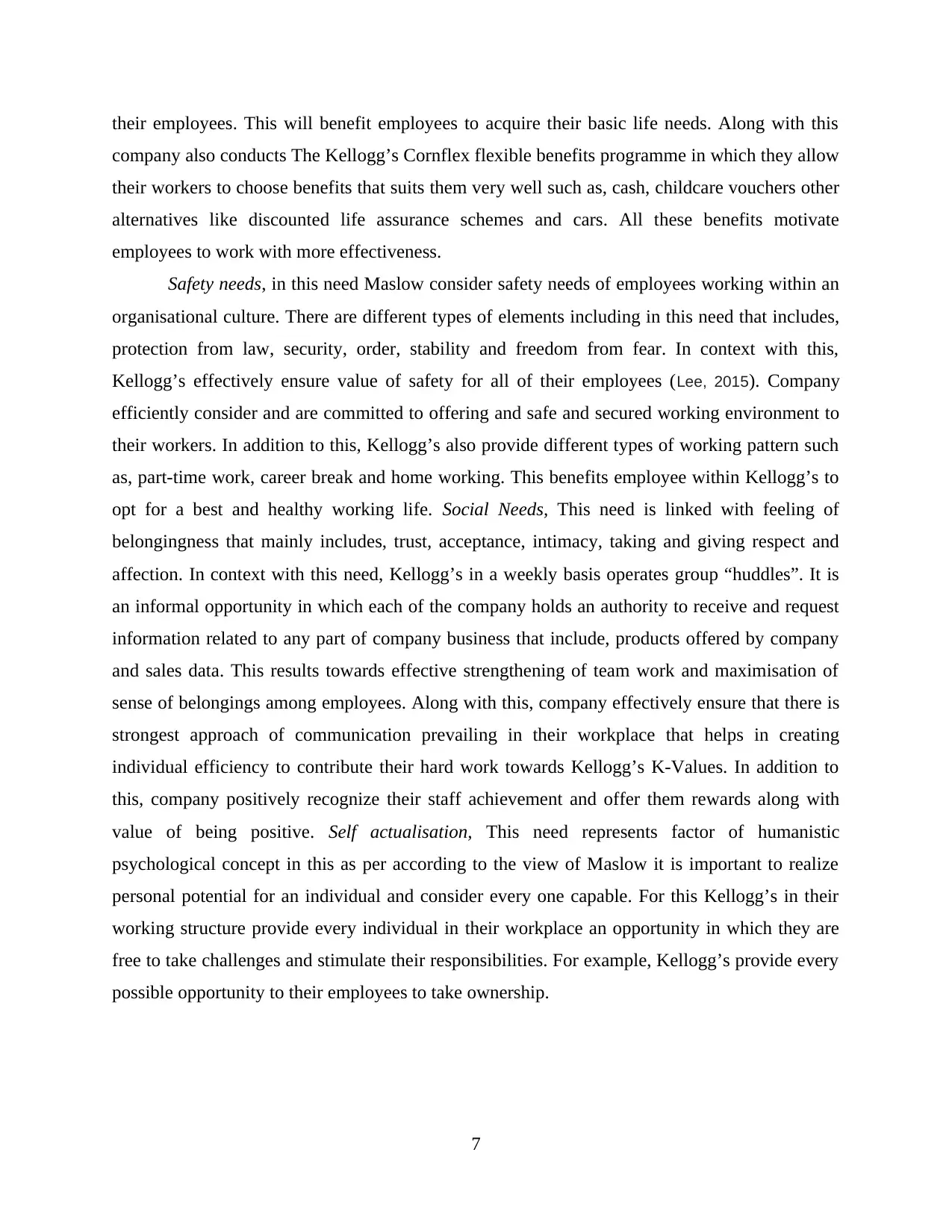
their employees. This will benefit employees to acquire their basic life needs. Along with this
company also conducts The Kellogg’s Cornflex flexible benefits programme in which they allow
their workers to choose benefits that suits them very well such as, cash, childcare vouchers other
alternatives like discounted life assurance schemes and cars. All these benefits motivate
employees to work with more effectiveness.
Safety needs, in this need Maslow consider safety needs of employees working within an
organisational culture. There are different types of elements including in this need that includes,
protection from law, security, order, stability and freedom from fear. In context with this,
Kellogg’s effectively ensure value of safety for all of their employees (Lee, 2015). Company
efficiently consider and are committed to offering and safe and secured working environment to
their workers. In addition to this, Kellogg’s also provide different types of working pattern such
as, part-time work, career break and home working. This benefits employee within Kellogg’s to
opt for a best and healthy working life. Social Needs, This need is linked with feeling of
belongingness that mainly includes, trust, acceptance, intimacy, taking and giving respect and
affection. In context with this need, Kellogg’s in a weekly basis operates group “huddles”. It is
an informal opportunity in which each of the company holds an authority to receive and request
information related to any part of company business that include, products offered by company
and sales data. This results towards effective strengthening of team work and maximisation of
sense of belongings among employees. Along with this, company effectively ensure that there is
strongest approach of communication prevailing in their workplace that helps in creating
individual efficiency to contribute their hard work towards Kellogg’s K-Values. In addition to
this, company positively recognize their staff achievement and offer them rewards along with
value of being positive. Self actualisation, This need represents factor of humanistic
psychological concept in this as per according to the view of Maslow it is important to realize
personal potential for an individual and consider every one capable. For this Kellogg’s in their
working structure provide every individual in their workplace an opportunity in which they are
free to take challenges and stimulate their responsibilities. For example, Kellogg’s provide every
possible opportunity to their employees to take ownership.
7
company also conducts The Kellogg’s Cornflex flexible benefits programme in which they allow
their workers to choose benefits that suits them very well such as, cash, childcare vouchers other
alternatives like discounted life assurance schemes and cars. All these benefits motivate
employees to work with more effectiveness.
Safety needs, in this need Maslow consider safety needs of employees working within an
organisational culture. There are different types of elements including in this need that includes,
protection from law, security, order, stability and freedom from fear. In context with this,
Kellogg’s effectively ensure value of safety for all of their employees (Lee, 2015). Company
efficiently consider and are committed to offering and safe and secured working environment to
their workers. In addition to this, Kellogg’s also provide different types of working pattern such
as, part-time work, career break and home working. This benefits employee within Kellogg’s to
opt for a best and healthy working life. Social Needs, This need is linked with feeling of
belongingness that mainly includes, trust, acceptance, intimacy, taking and giving respect and
affection. In context with this need, Kellogg’s in a weekly basis operates group “huddles”. It is
an informal opportunity in which each of the company holds an authority to receive and request
information related to any part of company business that include, products offered by company
and sales data. This results towards effective strengthening of team work and maximisation of
sense of belongings among employees. Along with this, company effectively ensure that there is
strongest approach of communication prevailing in their workplace that helps in creating
individual efficiency to contribute their hard work towards Kellogg’s K-Values. In addition to
this, company positively recognize their staff achievement and offer them rewards along with
value of being positive. Self actualisation, This need represents factor of humanistic
psychological concept in this as per according to the view of Maslow it is important to realize
personal potential for an individual and consider every one capable. For this Kellogg’s in their
working structure provide every individual in their workplace an opportunity in which they are
free to take challenges and stimulate their responsibilities. For example, Kellogg’s provide every
possible opportunity to their employees to take ownership.
7
Paraphrase This Document
Need a fresh take? Get an instant paraphrase of this document with our AI Paraphraser
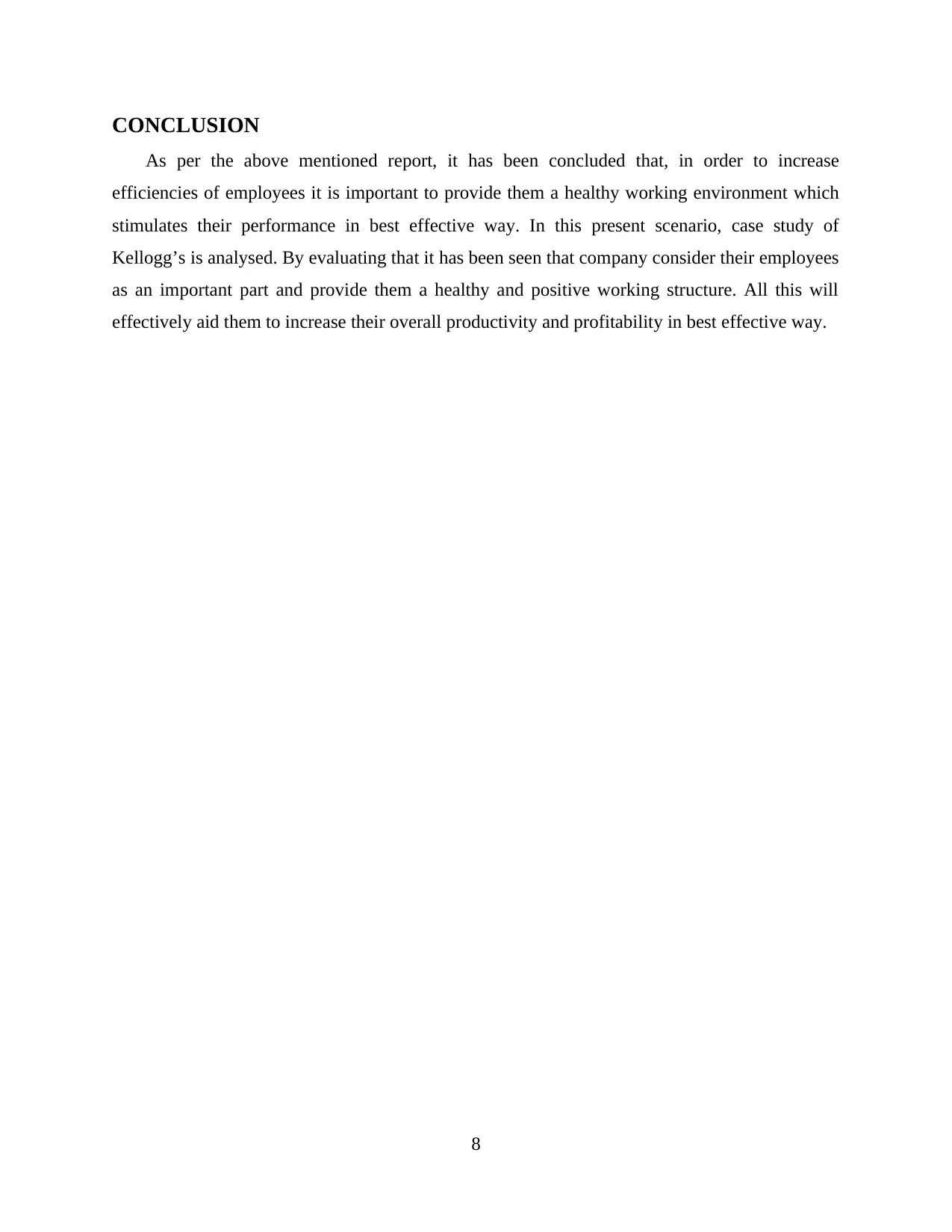
CONCLUSION
As per the above mentioned report, it has been concluded that, in order to increase
efficiencies of employees it is important to provide them a healthy working environment which
stimulates their performance in best effective way. In this present scenario, case study of
Kellogg’s is analysed. By evaluating that it has been seen that company consider their employees
as an important part and provide them a healthy and positive working structure. All this will
effectively aid them to increase their overall productivity and profitability in best effective way.
8
As per the above mentioned report, it has been concluded that, in order to increase
efficiencies of employees it is important to provide them a healthy working environment which
stimulates their performance in best effective way. In this present scenario, case study of
Kellogg’s is analysed. By evaluating that it has been seen that company consider their employees
as an important part and provide them a healthy and positive working structure. All this will
effectively aid them to increase their overall productivity and profitability in best effective way.
8
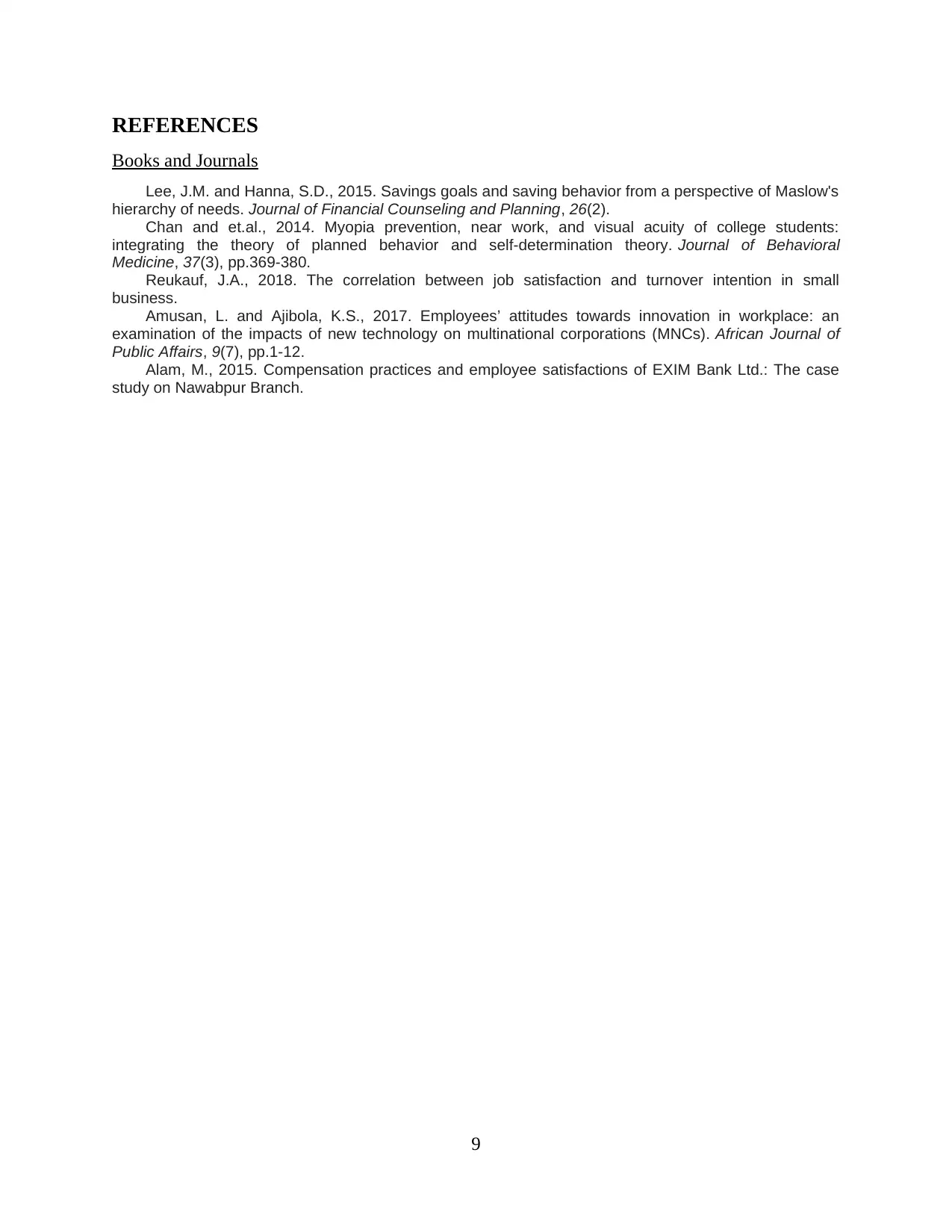
REFERENCES
Books and Journals
Lee, J.M. and Hanna, S.D., 2015. Savings goals and saving behavior from a perspective of Maslow's
hierarchy of needs. Journal of Financial Counseling and Planning, 26(2).
Chan and et.al., 2014. Myopia prevention, near work, and visual acuity of college students:
integrating the theory of planned behavior and self-determination theory. Journal of Behavioral
Medicine, 37(3), pp.369-380.
Reukauf, J.A., 2018. The correlation between job satisfaction and turnover intention in small
business.
Amusan, L. and Ajibola, K.S., 2017. Employees’ attitudes towards innovation in workplace: an
examination of the impacts of new technology on multinational corporations (MNCs). African Journal of
Public Affairs, 9(7), pp.1-12.
Alam, M., 2015. Compensation practices and employee satisfactions of EXIM Bank Ltd.: The case
study on Nawabpur Branch.
9
Books and Journals
Lee, J.M. and Hanna, S.D., 2015. Savings goals and saving behavior from a perspective of Maslow's
hierarchy of needs. Journal of Financial Counseling and Planning, 26(2).
Chan and et.al., 2014. Myopia prevention, near work, and visual acuity of college students:
integrating the theory of planned behavior and self-determination theory. Journal of Behavioral
Medicine, 37(3), pp.369-380.
Reukauf, J.A., 2018. The correlation between job satisfaction and turnover intention in small
business.
Amusan, L. and Ajibola, K.S., 2017. Employees’ attitudes towards innovation in workplace: an
examination of the impacts of new technology on multinational corporations (MNCs). African Journal of
Public Affairs, 9(7), pp.1-12.
Alam, M., 2015. Compensation practices and employee satisfactions of EXIM Bank Ltd.: The case
study on Nawabpur Branch.
9
⊘ This is a preview!⊘
Do you want full access?
Subscribe today to unlock all pages.

Trusted by 1+ million students worldwide
1 out of 9
Related Documents
Your All-in-One AI-Powered Toolkit for Academic Success.
+13062052269
info@desklib.com
Available 24*7 on WhatsApp / Email
![[object Object]](/_next/static/media/star-bottom.7253800d.svg)
Unlock your academic potential
Copyright © 2020–2025 A2Z Services. All Rights Reserved. Developed and managed by ZUCOL.





